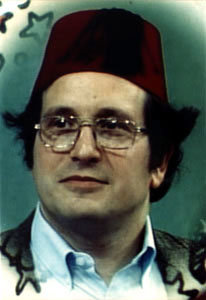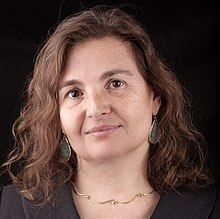
Gerald Jay Sussman is the Panasonic Professor of Electrical Engineering at the Massachusetts Institute of Technology (MIT). He has been involved in artificial intelligence (AI) research at MIT since 1964. His research has centered on understanding the problem-solving strategies used by scientists and engineers, with the goals of automating parts of the process and formalizing it to provide more effective methods of science and engineering education. Sussman has also worked in computer languages, in computer architecture, and in Very Large Scale Integration (VLSI) design.

Computer Science and Artificial Intelligence Laboratory (CSAIL) is a research institute at the Massachusetts Institute of Technology (MIT) formed by the 2003 merger of the Laboratory for Computer Science (LCS) and the Artificial Intelligence Laboratory. Housed within the Ray and Maria Stata Center, CSAIL is the largest on-campus laboratory as measured by research scope and membership. It is part of the Schwarzman College of Computing but is also overseen by the MIT Vice President of Research.

Charles Eric Leiserson is a computer scientist and professor at Massachusetts Institute of Technology (M.I.T.). He specializes in the theory of parallel computing and distributed computing.

Marc Raibert is the Executive Director of the Boston Dynamics AI Institute, a Hyundai Motor Group organization that is focused on solving the most important problems in robotics and artificial intelligence to achieve fundamental advances in the engineering and science of robotics. Raibert was the founder, former CEO, and now Chairman of Boston Dynamics, a robotics company known for creating BigDog, Atlas, Spot, and Handle.
The following outline is provided as an overview of and topical guide to artificial intelligence:
Leslie Pack Kaelbling is an American roboticist and the Panasonic Professor of Computer Science and Engineering at the Massachusetts Institute of Technology. She is widely recognized for adapting partially observable Markov decision processes from operations research for application in artificial intelligence and robotics. Kaelbling received the IJCAI Computers and Thought Award in 1997 for applying reinforcement learning to embedded control systems and developing programming tools for robot navigation. In 2000, she was elected as a Fellow of the Association for the Advancement of Artificial Intelligence.

Andrew Yan-Tak Ng is a British-American computer scientist and technology entrepreneur focusing on machine learning and artificial intelligence (AI). Ng was a cofounder and head of Google Brain and was the former Chief Scientist at Baidu, building the company's Artificial Intelligence Group into a team of several thousand people.
Machine ethics is a part of the ethics of artificial intelligence concerned with adding or ensuring moral behaviors of man-made machines that use artificial intelligence, otherwise known as artificial intelligent agents. Machine ethics differs from other ethical fields related to engineering and technology. It should not be confused with computer ethics, which focuses on human use of computers. It should also be distinguished from the philosophy of technology, which concerns itself with technology's grander social effects.
Radhika Nagpal is an Indian-American computer scientist and researcher in the fields of self-organising computer systems, biologically-inspired robotics, and biological multi-agent systems. She is the Augustine Professor in Engineering in the Departments of Mechanical and Aerospace Engineering and Computer Science at Princeton University. Formerly, she was the Fred Kavli Professor of Computer Science at Harvard University and the Harvard School of Engineering and Applied Sciences. In 2017, Nagpal co-founded a robotics company under the name of Root Robotics. This educational company works to create many different opportunities for those unable to code to learn how.
Julie Shah is the Department Head of Aeronautics and Astronautics at the Massachusetts Institute of Technology and director of the Interactive Robotics Group at the MIT Computer Science and Artificial Intelligence Laboratory.

Professor Emma Hart, FRSE is an English computer scientist known for her work in artificial immune systems (AIS), evolutionary computation and optimisation. She is a professor of computational intelligence at Edinburgh Napier University, editor-in-chief of the Journal of Evolutionary Computation, and D. Coordinator of the Future & Emerging Technologies (FET) Proactive Initiative, Fundamentals of Collective Adaptive Systems.
Regina Barzilay is an Israeli-American computer scientist. She is a professor at the Massachusetts Institute of Technology and a faculty lead for artificial intelligence at the MIT Jameel Clinic. Her research interests are in natural language processing and applications of deep learning to chemistry and oncology.
Carol Elizabeth Reiley is an American business executive, computer scientist, and model. She is a pioneer in teleoperated and autonomous robot systems in surgery, space exploration, disaster rescue, and self-driving cars. Reiley has worked at Intuitive Surgical, Lockheed Martin, and General Electric. She co-founded, invested in, and was president of Drive.ai, and is now CEO of a healthcare startup, a creative advisor for the San Francisco Symphony, and a brand ambassador for Guerlain Cosmetics. She is a published children's book author, the first female engineer on the cover of MAKE magazine, and is ranked by Forbes, Inc, and Quartz as a leading entrepreneur and influential scientist.
Ashutosh Saxena is an Indian-American computer scientist, researcher, and entrepreneur known for his contributions to the field of artificial intelligence and robotics. His research interests include deep learning and physical AI for autonomous systems. Saxena is the co-founder and CEO of Caspar.AI, which uses AI with data from ambient 3D radar sensors to predict 20+ health & wellness markers for patients. Prior to Caspar.AI, Ashutosh co-founded Cognical Katapult, which provides a no credit required alternative to traditional financing for online and omni-channel retail. Before Katapult, Saxena was an assistant professor in the Computer Science Department and faculty director of the RoboBrain Project at Cornell University.

Joëlle Pineau is a Canadian computer scientist and Associate Professor at McGill University. She is the global Vice President of Facebook Artificial Intelligence Research (FAIR), now known as Meta AI, and is based in Montreal, Quebec. She was elected to the Fellow of the Royal Society of Canada in 2023.

Una-May O'Reilly is an American computer scientist and leader of the Anyscale Learning For All (ALFA) group at the MIT Computer Science and Artificial Intelligence Laboratory.
Abeba Birhane is an Ethiopian-born cognitive scientist who works at the intersection of complex adaptive systems, machine learning, algorithmic bias, and critical race studies. Birhane's work with Vinay Prabhu uncovered that large-scale image datasets commonly used to develop AI systems, including ImageNet and 80 Million Tiny Images, carried racist and misogynistic labels and offensive images. She has been recognized by VentureBeat as a top innovator in computer vision and named as one of the 100 most influential persons in AI 2023 by TIME magazine.
Cynthia R. Sung is an American roboticist known for her research on foldable robots. She is Gabel Family Term Assistant Professor of Mechanical Engineering & Applied Mechanics, with a secondary appointment in the Department of Computer and Information Science, at the University of Pennsylvania.

Karen Ann Panetta is an American computer engineer and inventor who is a professor and Dean of Graduate Education at Tufts University. Her research considers machine learning and automated systems. She is a Fellow of the Institute of Electrical and Electronics Engineers, the American Institute of Aeronautics and Astronautics and the National Academy of Inventors. She is a member of the National Academy of Engineering, and Fellow of the European Academy of Sciences and the Arts, and the Asia-Pacific Artificial Intelligence Association. She was the STEM Advisor to President Joyce Banda of Malawi and U.S. Ambassador to Slovenia, Linda Blanchard.

Chelsea Finn is an American computer scientist and assistant professor at Stanford University. Her research investigates intelligence through the interactions of robots, with the hope to create robotic systems that can learn how to learn. She is part of the Google Brain group.










